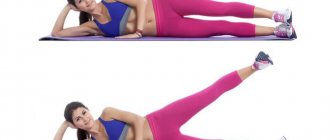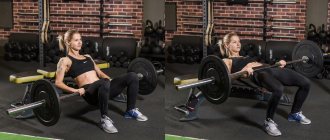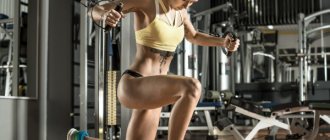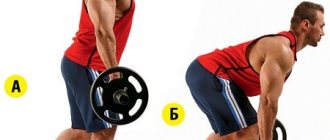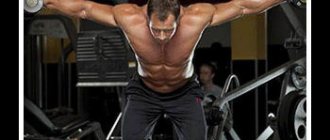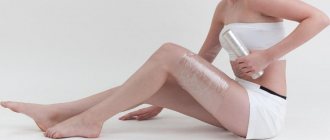Leg swings are rhythmic movements of them in turn with a change in the usual position relative to the body. They can be forward, backward, to the sides, performed standing, lying down, on all fours and with weights or on simulators. They use a crossover, a Smith machine, dumbbells, and a donkey. This part of the workout should be done at the end, after jumping, squats, jogging, deadlifts and presses.
But even then, swings will not help you get rid of excess weight; they only help reduce it along with diet and other types of exercise. After all, only up to 20 kcal are burned per minute of exercise. And only with regular training with 3 sets of 20-30 repetitions.
Leg swings: basic knowledge
Swings with legs straight or bent at the knees should be done at every lesson, and not from time to time . It is necessary to ensure that the muscles of the trained area of the body, and not the back, are tensed, that is, control the posture. It is important to pay attention to side swings. They work the gluteus medius muscles to keep this area round. With this option, the adductor and femoral muscles are also involved.
But for the proportionality of the figure, it is equally important to do abductions back and forth. Swings are also useful because they help get rid of cellulite, “breeches” on the hips, and make your legs slimmer. Therefore, your training should include rhythmic movements from standing positions, lying on your side, from the cat pose, using weights, elastic bands on the cuff, and a crossover.
We recommend reading the article about exercises for losing weight on legs and thighs. From it you will learn about the rules of training, effective exercises to perform while standing, lying down, and how to get quick results. And here is more information about exercises with a chair for weight loss.
How to do leg swings correctly
You can swing your legs correctly and effectively if you meet several conditions:
- Regularity. Exercises give results, but not immediately, but after 4-5 weeks. Therefore, it is important to find a place for mahams in the overall set of activities.
- Complexity. In order for the upper legs and buttocks to become not only slim, but also harmonious in shape, it is important to perform different types of exercises - forward, backward, to the sides. This will allow the muscles to evenly tighten and strengthen.
- Using weights. There are special ankle pads with different weights. At the first stage of training, you can do without them, but later you should wear weights or fitness bands.
- Watch your posture. Even when the exercises are performed lying on your side, you should try to keep your back straight. This will put more stress on the gluteal muscles and thigh area.
Swing your legs to the side: what muscles work?
When swinging your legs to the side, the following muscles work:
- Gluteal medius when outward movement occurs. This type of technique is useful because it prevents your butt from becoming square.
- Adductor, that is, located on the inner surface of the thigh when moving to the other leg. It makes the upper part slimmer and smoother.
- Lateral thigh area. It works both when moving the leg to the side and when moving it inward. This allows you to get rid of the “breeches”.
- Lower back muscles. The load on them is especially strong if the exercise is performed in a lying position.
Types of exercises
Swings are performed to the sides, forward, backward, from a standing position, on all fours, as well as lying on your side and back. At the first stage, while the muscles are not yet ready for serious loads, you can do some exercises with your knees slightly bent. As they strengthen, you should ensure that they are straight.
Swing to the side
Leg movements to the side can be performed in several ways:
| Position | How to perform |
| Standing and holding onto a support that is in front | The leg is rhythmically moved to the side so that an obtuse angle is formed between it and the second lower limb each time. The same can be done by moving it inside. That is, the right leg goes to the left, and when they change, the left leg goes to the right. |
| From a position on all fours, the palms of the straightened arms rest on the floor, the knees are also on the mat | The back should be straight during the exercise, without bending. At a fairly fast pace, you need to move your leg bent at the knee up and to the side, not lowering it all the way down. |
| Lying on your side | If your left leg is working, you need to sit on your right leg, bend the same arm at the elbow and place it under your head. The left palm should be used to maintain body balance by placing it in front of the chest on the mat. The straight leg should be rhythmically moved up and to the side and lowered. |
| From plank pose | I pull the knee of one leg towards my chest and return it to its original position. Then they are changed. |
Lying on your side
From a lying position on your side, perform sideways movements as follows:
- sit on the mat in the starting position;
- bend the supporting leg slightly at the knee for greater stability;
- you can support your head with your hand, resting your elbow on the mat;
- Raise the second leg up relative to the floor and at the same time to the side.
The exercise from the same position can be varied. The working leg is the one that lies on the mat, for example, the left one. It should be retracted inward, that is, towards the second lower limb. During execution, the right leg should be bent at the knee so that the foot rests on the floor.
On knees
From the pose on all fours you can perform two exercises:
- Stand up using your elbows and one knee as support. That is, everything is done through emphasis on bent arms. The second leg should be extended and raised slowly up, held there, then lowered. The back must be kept straight and controlled so that the load falls on the buttocks and not the lower back.
- Starting position, as in the previous case. You should only lift your half-bent leg up. Then they return to their previous position.
standing
From a standing position, movements of the legs to the sides (external and internal) are performed, as well as:
- Swing back. There needs to be a support in front that you can hold on to with your hand. The leg should be pulled back as much as possible many times until the muscles become tense.
- Swing forward. Here the support should be on the side so as not to interfere with the main movement. The leg is raised so that the back does not bend.
On the back
Lying on your back to “polish” the inner thighs, do the following:
- in the starting position, straight legs are raised up almost at a right angle to the body;
- at the same time move them as far apart as possible;
- slowly return back, bringing each other closer.
For greater effect, this exercise should be performed with weights. From the same position, you can simply lift your straightened legs from the floor and to the maximum possible height, closer to the body. But in this case, the load on the muscles will be gentle.
For large buttocks
For the gluteus maximus muscles, which have a significant volume, an exercise from a position on all fours is suitable. You should lean on the palms of your straightened arms and knees. One leg should be stretched straight out, simultaneously moving back, the second should be bent on the floor. Each person should do 20-30 swings in a row. Then the legs are changed.
For greater effect, weights are used. You can also use your elbows instead of your palms for support, that is, bend your arms. Then the lower part of the body will be lower than the hips, which will also increase the load on the gluteal muscles.
Back swings can also be done while standing with each leg in turn. To enhance the effect, you need to use an elastic band or weighting agent. When the leg is at the highest point, you should hold it in this position, only then lower it.
The exercises cause noticeable tension in the gluteus maximus muscle. It is this that makes up the largest portion of this area of the body. The back of the thigh is also pumped.
The benefits of leg swings for women
The benefits of leg swings exist for all women, regardless of weight, and are as follows:
- strengthening the muscles of the buttocks, tightening, and therefore improving the shape of this area;
- increased blood circulation in the trained area, that is, getting rid of cellulite and smoothing the skin;
- improving the shape of the hips, as the muscles of the inner surface are tightened and shortened, which helps get rid of slight curvature in this area;
- unloading of joints, as strong muscles help relieve excess tension from them when moving.
For those losing weight, swings will also add stress, which will have a beneficial effect on weight. After all, efforts are made to complete them, that is, energy is spent.
How many calories are burned
Performing different exercise variations burns from 4 to 20 calories per minute. It depends on the intensity of the workout, the number of approaches and the number of leg swings. The most energy is spent when performing exercises from a position on all fours or a “plank”. The use of weights and cables increases the load.
Techniques for performing different types of swings
So, how to perform leg swings correctly? Let's consider all the options: back (hip extension), forward and to the sides.
Swing back
This type of swing is designed to train the hamstrings and gluteus maximus muscles. It is these muscles that make up the bulk of the buttocks.
The starting position can be standing or resting on your elbows and knees.
The standing position is used when you do kickbacks on the machine. It doesn't matter whether you're pulling a pulley cable or pushing a roller with your hip, as a rule, all of these machines involve a standing position. It also makes sense to do it while standing if you cannot stand on your knee for medical reasons.
The technique for doing it at home is as follows:
- Stand up straight and rest your hands on the back of a chair, table or any other support. Secure your lower back; there should be no arching in your back during the movement.
- Extend your straight leg back as far as possible. At the same time, the foot is contracted, you reach up with your heel. The position of the back remains unchanged, only the buttock and thigh work. Gently lower the sock to the floor.
The position of the emphasis on the knees and elbows is more effective in terms of working out the muscles. Firstly, the range of motion in the hip joint is greater in this case. Secondly, you can swing either with a straight leg or with it bent at the knee, thereby transferring the emphasis of the load to the buttock. Of course, it is also possible to abduct a bent leg while standing, but it is not entirely convenient.
So, to emphasize the back of the thigh:
- Support yourself on your elbows and knees. The back is straight, the lower back does not sag, the neck is a continuation of the back, i.e. there is no need to lift your head. Straighten your working leg back and place your foot on your toes.
- Raise your straight leg, trying to reach up with your heel. Do not try to raise your leg higher by bending your lower back - your back is fixed. Lower your leg and repeat the movement as many times as necessary.
To accentuate the buttocks:
- The starting position is the same as in the previous version - emphasis on the knees and elbows. Just don’t put your foot back.
- Raise your leg, bent at the knee, and straighten it slightly at the top, as if your task is to push through the ceiling with your heel. You should feel the active work of the gluteal muscles, fix your lower back. Lower your leg.
Theoretically, you can perform backward leg swings on the floor, however, in this case you need to use a soft mat, since unpleasant pressure may be placed on the pelvic bones.
Swing forward
This exercise develops the quadriceps, or front part of the thigh. The hip joint allows you to move the leg forward with a large amplitude, so the movement is quite simple.
- Stand up straight and grab a wall or other support with one hand.
- Shorten your foot and lift your straight leg up to the maximum height without rounding your back. Lower your leg.
By the way, in addition to the quadriceps, the abdominal muscles work. You can also do it lying down, but the load in this case is quite insignificant.
Swing away from yourself (abduction)
This exercise allows you to work the gluteus medius muscles, which give the buttocks a rounded, toned shape. You can do it standing, on all fours, or lying on your side. In the gym, you can also use simulators for such swings.
Standing technique:
- Stand up straight, grab a support with one hand.
- Shorten your foot and move your straight leg to the side as far as your hip joint will allow. In this case, the spine does not bend, and the body does not tilt in the opposite direction. Lower your leg down.
On knees:
- Support yourself on your knees and elbows. You will need to place one hand on the palm. This should be the same hand with which leg you will do the exercise. The elbow of this arm remains slightly bent. Straighten your working leg, move it to the side and shorten your foot.
- Raise your leg up and lower it to the starting position. If performing the exercise with a straight leg is still too difficult for you, bend it at the knee and swing your knee to the side.
Leg swings lying on your side:
- Lie on your side. Prop your head with your hand or lean on your elbow. Place your other hand in front of you. The leg that is located below can be slightly bent at the knee to give stability to the pose.
- Raise and lower your straight leg. You can move it forward a little. The foot, as always, is in a contracted position.
Do they help burn fat?
Exercise, of course, helps you lose weight, but it should be in addition to cardio training, walking or running and strength training, as well as a balanced diet. You shouldn’t expect significant weight loss from swings alone, as they rather improve the contours of a specific area of the body.
This type of training should be the final part of the overall complex. Moreover, swings should be performed in all possible directions so that every muscle of the buttocks and thighs is involved. Otherwise, the figure will become disproportionate, and joint pain may appear.
Watch the video about the benefits of leg swings:
Leg swings for buttocks
Leg swings for rounded buttocks involve performing exercises to the sides, forward, but the best effect is obtained by moving the legs back:
- you need to get on all fours with emphasis on the palms of your outstretched arms and knees;
- move the bent left leg, leave the right leg in place;
- hold for 10-30 seconds;
- return to the starting position;
- do the same with the other leg.
This exercise should be the final one in this training block.
Taking the leg back
Difficulty is low. Works the back of the thigh and gluteal muscles.
This is probably one of the simplest and most popular exercises with small weights for the buttocks. The thigh muscles are also involved.
- Starting position - standing, join your feet, put your hands on your waist.
- As you exhale, gently move your straight left leg back as far as it will go, maintaining a straight and stable position.
We perform 10-15 repetitions and repeat the exercise for our right leg.
More details in the video:
Swing your legs with an elastic band back
Leg swings with an elastic band, if done backwards, contribute to the development of not only the gluteal muscles, but also the calf muscles, they are performed like this:
- standing in front of the support, you need to fix the expander in its lower part;
- its second end is attached to the ankle;
- holding the upper segment of the support with your hand, perform back swings at a slow pace;
- do the same with the other leg.
The exercise is performed in the same way from a position on all fours. During the process of abduction and simultaneous lifting, the leg bent at the knee, to which the expander is attached, straightens.
It is more convenient to do both exercises with weights. Essentially this is the same increased load on the muscles. The devices are put on the ankles and swings are performed with them as described above. It is important to be careful; movements should be less sudden than without additional load.
Incorporating exercise into the training process
Leg kicks should be performed at the end of a complex workout for the hips and buttocks. It is well suited for finishing off the gluteal muscles.
Choose light or medium weight. You should be able to do 2-3 sets on each leg for 12-15 repetitions.
Combine back kicks with glute medius exercises for maximum benefit. In particular, the gluteus medius involves lateral hip abduction, which you can do at the same time, which is called “without leaving the cash register.”
Leg swings for losing weight on the inner thighs
Leg swings help to lose weight on the inner surface of the ankles if you do them like this:
- Lie on your left side, bend your right leg at the knee and place it slightly in front of your left. You can lie down completely on the mat or perform the exercise with your head raised. Its main part is that you need to swing with your left leg straightened inward. Then you should turn to the right side and repeat.
- Stand with your back to the support, hold on to it with one hand, and place the other on your belt. Perform swings first with your right leg (straight) in the appropriate direction, then with the same leg to the left. This will strengthen the inner thighs, but will also prevent the outer thighs from relaxing. Then they do the same with the left foot.
- Attach weights to your ankles, lie on your back, raise your legs at a right angle, trying not to bend them. Then they should be slowly pulled apart and brought together slowly, too.
- Take a cat pose with emphasis on your palms and knees. Without straightening one leg, rhythmically move it to the side, then do the same with the other.
- Get on your knees, slightly leaning your body to the left and hold on to the support on this side. Without straightening, lift the right leg to the side to the level of the pelvis. Run several times. Then do the same with the other leg.
- Lie on your side, leaning on your elbow. Make circular movements with the leg that is on top, bending and straightening it. Change position, sitting on the other side, and do the same.
These exercises should be in addition to squats and wide lunges to the sides.
Swing your legs while lying on your side
An excellent exercise, a slightly more difficult adduction or abduction exercise that you already know how to do while standing.
To take the starting position, lie on your side. Support your head with your hand. If it is more convenient, you can lean on your elbow. The other hand lies freely in front of you. The “lower” leg is slightly bent. Your task is to raise and lower your straight leg (toe towards you). If you want to perform an adduction, then take the starting position as for the previous exercise.
The main difference is that the working leg will be the lower one. Bring it forward a little, the toe, as usual, looking at itself. The upper leg should be slightly bent and placed on the foot. You need to raise and lower your working leg smoothly and without jerking.
Swing your legs in a crossover
It is useful to do leg swings to pump up the buttocks and thighs in a crossover:
- secure the expander to the foot using a cuff;
- stand in cat pose on a bench, facing the support available in the simulator;
- slowly move back, while simultaneously lifting and straightening the leg with the expander;
- hold it at this level, feeling the load on the buttocks;
- lower slowly.
The exercise is repeated up to 20 times with one leg, then the expander is attached to the other and swings are performed with it.
The technique and meaning of this action for girls is to stretch the muscles of the gluteal region as much as possible and immediately contract them, while maintaining tension.
Crossover can also be used to perform lateral leads. The expander cuff, in the same way as in the previous case, clings first to one ankle, then to the other. To maintain balance, you should hold onto the handle of the machine.
What muscles work
The target muscles are the large gluteal structures. Additionally, the small hip extensor muscles are involved in the work. Extremely isolated loads can be organized using special training equipment.
When performing the exercise in a standing position, the stabilizing muscles of the thigh are involved, and the latissimus dorsi muscle is actively involved in the work. The body is supported by the abdominal structures, which absorb part of the load.
The main working muscles when abducting the legs and hips in the simulator
Depending on the technique and body position in the simulator, you can use:
- biceps forearm;
- anterior deltoids;
- rounded back muscles;
- muscles of the chest.
They come into operation when you rest on your palms and knees. The main load always falls on the buttocks and hip abductors - the muscle groups that abduct the lower limb.
How to pump up your legs in bodybuilding
To give beautiful shape to the leg muscles, you should do the following:
| Exercise | How to perform |
| Jumping rope | You need to start with 20-30 times in one approach, increasing the duration of the exercise and the pace. |
| Straight lunges | From a standing position, you should raise your leg and bend the knee to 90 degrees, at the same time raise your arms and fold your palms. Take a wide step forward, pause for 3 seconds, and return to your previous position. Do not lower your working leg until 10-12 repetitions have been completed. |
| Side Lunges | Done from a standing position, feet shoulder-width apart, hands on the belt. You need to take a large step to the side, stand up and sit down several times from this pose, and then return to the starting position. |
| Squats | Performed on widely spaced legs. To increase the load, you can pick up dumbbells. |
The final stage of training should be swings with weights. It is necessary to perform them in all possible directions.
Forward
These leg swings for slimming the thighs pay more attention to the front surface. But don’t worry, you won’t overwork , especially with a load in the form of your own weight. The complexity of the execution is not high, you can wear weights.
Technique:
- Starting position – standing on two legs, back straight, looking forward, hands on your belt;
- While inhaling, we swing the straight leg as high as possible , pull the toe towards ourselves, strive for the position of the thigh parallel to the floor;
- After exhaling, we return to the starting point and repeat the actions on the other side.
Learn more from the video:
For the best impact, you should do 18-20 swings in 3-5 approaches.
“Star” exercise technique and example program
The “star” for pumping the hips can be performed in several ways:
- Stand with your knees slightly bent and your feet 10 cm apart, your arms along your body. Jump, spreading your legs and placing them wider as you return to the floor. At the same time, you need to raise your arms and clap your hands above your head. The exercise is repeated several times without pauses between movements.
- Take the same starting position as in the previous case. Jump, but cross your arms and legs. On the next jump, return to the starting position, then repeat, and so on several times.
- Start the exercise from the same position. But when jumping, spread your arms and legs as wide as possible to the sides.
"Star" can be included in the following program:
- 20 squats on spread legs;
- make a “star” the same number of times;
- 20 “climber” exercises (from the “plank” position in a jump, alternately bend your knees);
- Perform another version of the “star” 20 times;
- perform the “chair” exercise once (press your back against the wall and sit down with support on it so that an angle of 90 degrees is formed between the thigh and lower leg, hold for at least 30 seconds);
- 25 swings to the sides from a standing position.
Between actions you need to take 20-second pauses.
Lumberjack exercise
To perform the “lumberjack” you will need a crossover with an expander attached to the upper block. You need to grab the handle while standing facing the machine, with your feet spread almost shoulder-width apart. Then turn your body to the left, lowering your hands down and towards your left leg. The right lower limb also rotates slightly, and both of them bend slightly at the knees.
After returning to the starting position, the exercise is done in the other direction. There should be no pauses between them until the specified number of repetitions has been completed.
“Lumberjack” can be diversified, for example, by lowering your hands and doing a squat. Or perform it from the starting position, standing on the right knee with the body turned in the same direction, on the left - to the left. The exercise can be done with a dumbbell in your hands and on the lower crossover block. Its band is attached to the ankle.
Watch the video about performing the “lumberjack” exercise:
Exercise “donkey” for calves: how to pump up muscles, technique of execution
“Donkey” is performed on a special simulator:
- the load is secured to the main beam;
- sit on a chair, holding the control handle;
- they pull her towards them, at the same time raising themselves on their toes, but getting up from the seat;
- push away, lowering the heels.
The simulator is designed in such a way that with any change in the position of the feet relative to the floor, the calf muscles become tense. But the “donkey” can be done without it:
- you need to stand in front of the support, holding it with your hands;
- bend forward at a right angle;
- put a weight on your lower back;
- without changing the position of the body, stand on your toes and lower yourself onto your entire foot.
You can do the exercises with your feet parallel, then bring your toes or heels closer and repeat.
Swing back with support
Back swings are performed:
| Position | How to perform |
| Standing on straight legs | In this case, the support is a chair or a wall. The leg should be moved as far as possible with the heel up and lowered almost to the floor level. The lower back remains motionless, the load should go to the buttocks. The exercise is performed first for one leg, then for the other. |
| On all fours | In this case, a wide bench becomes a support. They hold onto it with their palms, the knee of one leg also stands on it. The other should be straightened and raised high with the heel up and lowered. Do several repetitions, change legs. The back should be straight, the lower back should not be involved in the movement. |
| On all fours | But each leg should be moved back with the knee bent. |
To the side
The gluteal muscle takes on the killer load in this type of swing, pumping up and pulling up perfectly. Implementation complexity is below average.
With emphasis on the feet
- Starting position – standing on your feet, back straight, arms extended forward for balancing;
- As you inhale, move your straight leg to the side with maximum amplitude, the toe stretches away from you ;
- Exhaling, we return the leg to the starting position. Having completed, we carry out the action on the next side.
More details in the video:
Pay attention! When the leg is abducted, the body is positioned straight, it does not bend sideways following the movements. In what position you fixed your core, implement your swings in this way.
With emphasis on the knees
- Starting position - emphasis on the knee-elbow joints, the neck is one piece with the back, no deflections ;
- Inhaling, we move our straight leg to the side, with our toes turned away from us;
- As you exhale, return to the first position.
Lying on your side
- Starting position – lying on your side, emphasis on the shoulder, legs straight;
- Inhaling, lift your leg high up, without bending your knee , with your toe reaching towards the ceiling;
- As you exhale, slowly lower your leg.
These exercises should be performed briskly, in an excellent mood, at a working pace of 18-20 repetitions on each side in 4-5 approaches.
Exercising on a simulator in the gym for pumping legs
To improve the relief of your legs, perform the following exercises using exercise machines:
- Squats with a bar for fitness. You need to put it on the trapezius muscles, spread your legs wider, turn your feet with your toes towards each other. And do 12-15 deep squats.
- Leg presses using a special platform. You need to sit in a simulator chair, rest your foot on a vertical plane, the other is lowered down, but is without support. Then you should push off from the platform. Since the chair is installed at a downward angle, this requires tension in the muscles of the legs and hips. Do this several times on each limb in turn.
- Smith machine leg thrust. The barbell fixed in the simulator is taken with both hands and held down. The right leg is bent at the knee, the left is the supporting leg. Standing on the last one, you need to lean down with the barbell so that your torso becomes parallel to the floor. The right leg goes up; there is no need to straighten it. Then they return to the starting position, and do several tilts.
- Swings in the simulator. You need to put a cuff on your leg with an elastic cable, which is located in the lower block. Hands should hold onto the support. They are facing her. You need to do back bends. This is prevented by the cable and the load connected to it, so the muscles experience strong tension and are well pumped. Swings can also be done to the sides, but then you need to stand sideways to the support and hold on with one hand.
- Squats on two free-standing platforms with a kettlebell. Both of them are quite high, and there is a gap between them that allows you to lower the weight below the level of your feet. This puts the strain on your legs, not your arms or back. You need to stand on parallel platforms, take the weight with both hands, lowering them down. And squat deeply, spreading your knees to the sides.
- Smith machine lunges. The barbell is placed on the shoulders, the left foot is on the floor. The right one is laid back in a bent position, its toe resting on the bench located behind. You need to squat on your left leg. The right one goes down with the knee at the same time, it is advisable for them to touch the floor. The thigh and shin of the left leg should form a right angle in a squat.
- Lunges from a position on all fours in a crossover with a lower block. The cuff is placed on the ankle of the left leg. You need to stand on the bench facing the machine. And take your leg back, straightening it. You can also do lateral abductions from this position with the leg bent at the knee, raising it to the level of the pelvis.
Technique of swinging a straight leg backwards on all fours
The straight leg option is considered more difficult. It loads the hamstrings a little more, although as the amplitude increases, the increased load also falls on the buttocks.
Technique:
- Get on all fours, back straight, legs bent at right angles at the knees.
- Begin to move your leg back while straightening it at the knee joint.
- Try to raise your leg above the horizon, this will additionally load the gluteal muscles.
- It is also recommended to take a short pause at the top to improve efficiency.
- Lower your leg to the starting position.
